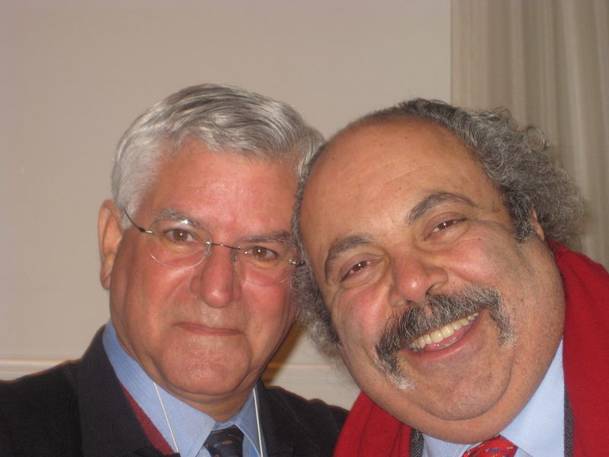


Vino 2011 is known as Italian Wine Week, though for me, one of the most interesting events was the panel discussion entitled “Has the Popularity of la Cucina Italiana Surpassed French Cuisine as the Source of Inspiration and Motivation for Future Chefs?”
The host was Fred Plotkin, an expert on all things Italian, author of “Italy for the Gourmet Traveller” and numerous articles and books on Italian food and opera, and a popular speaker and lecturer. Fred introduced the first panelist, Bob Lape, host of WCBS Radio 88’s Dining Diary for the past 15 years, and Emmy Award winning newscaster.
Bob told us about the amazing growth of Italian culinary influence in this country that he has witnessed over the years in his role as a food and restaurant industry commentator, while French cuisine has declined. He cited cooks like TV Chef and Author Mary Ann Esposito for introducing the public to the “honesty and simplicity of Italian foods” with her television show, Ciao Italia!, the longest-running cooking show on TV. Bob surveyed several of the top culinary schools and discovered strong indicators that Italian cuisine is the more popular. For example, the Italian Culinary Academy is expanding to California and New York’s Institute for Culinary Education current schedule lists 87 Italian cooking classes versus only 28 French.
Ariane Batterberry spoke next. Together with her late husband Michael Batterberry, Ariane was the founder of two major culinary periodicals, Food & Wine and Food Arts. Ariane recalled that in 1971 when she visited Menton, France near the Italian border, it was obvious that neither the French cooks nor their Italian counterparts on the other side of the border had any interest in emulating one another. Today culinary schools teach aspiring cooks French techniques, but those same cooks go on to work in American restaurants with menus inspired by Italian cuisine and ingredients. Some of the recent examples of menu items Ariane noted in American restaurants include Locavore Crostini with Mostarda, Pesto, Polenta and Pancetta; Seared Scallops with Porcini; Bucatini with Roasted Cauliflower and Pecorino; and Heritage Pork Ravioli. She said that this shows that Italian culinary concepts are so entrenched in the American kitchen that young chefs today accept foods like mostarda, ravioli and bucatini as American, not foreign.
Steven Kolpan is Professor and Chair of Wine Studies at The Culinary Institute of America in Hyde Park, New York and the author of “Exploring Wine”. He believes that Italian cuisine has risen in popularity because Italian food is recognizable, not overly manipulated, and based on the model of home cooking as opposed to that of restaurant and hotel food. He also pointed out that French haute cuisine is not food that people can or want to eat every day as evidenced by the fact that France is the fastest growing market for Mc Donald’s, and that the most popular book about French food in recent years is “Why French Women Don’t Get Fat”. Though Asians still revere French haute cuisine, Steven feels that its influence is declining in favor of other cuisines.
Darrell Corti, owner of Corti Brothers, a gourmet grocery and wine store in Sacramento questioned the notion of “popularity” of Italian food versus its “inspirational” ability and pointed out that popularity eventually fades. Italy as a country is only 150 years old, whereas France has been around since the 1500’s. Chefs today admire Italian cuisine because it uses good sense and simple ingredients.
The final speaker was Arthur Schwartz, known as “The Food Maven”, author of “Naples At Table” and “The Southern Italian Table.” Arthur pointed out that to predict the future, we should look to the past. In 2003, he said, Bon Appetit magazine cited Alain Ducasse as the premier chef in America, and few would agree with this today. While Italian food is popular at the moment, it may not continue to motivate and inspire chefs in the future. He cited the influences of globalization as today’s chefs seek fame around the world and prefer to startle the public and the press with novelty. He said that cooking schools report that anything Italian sells, but Italian cooking technique is not taught to professionals who still learn French technique. He feels that more education is needed but in the end Asian cuisine is winning out.
Summing up, Fred Plotkin pointed out that the Italians have always been creative people. He said that the most important thing is not to forget the past, and that Italians can learn a lot from the French. Like several of the other panelists, he credited the Italian Trade Commission and other Italian government agencies for introducing the American public to Italian food and wine. Italy’s strength is the high quality of the ingredients used in Italian cooking, using the 5 senses in the kitchen, and understanding that we are one with nature.
I think that American chefs are open to new ideas and love experimenting. This is a good thing and it’s the reason why there are so many exciting restaurants in this country. But for most of us, on a day-to-day basis, nothing is more appealing, satisfying, or doable than an Italian meal. If I was somehow transported to Copenhagen to dine at Noma, recently named the World’s Best Restaurant, where the specialties include radishes with edible dirt, and buttered langoustine on a hot rock, with milk skin and rape seed oil, I might enjoy the experience. But you won’t find me craving that kind of food, preparing meals like that at home, or going to a restaurant in my neighborhood that serves such dishes.
Italian food will always inspire and motivate future chefs because it is ultimately what they and their customers want to eat and enjoy the most.
Source URL: http://newsite.iitaly.org/magazine/dining-in-out/articles-reviews/article/la-cucina-italiana-inspiration-and-motivation
Links
[1] http://newsite.iitaly.org/files/16624img21181296747528jpg